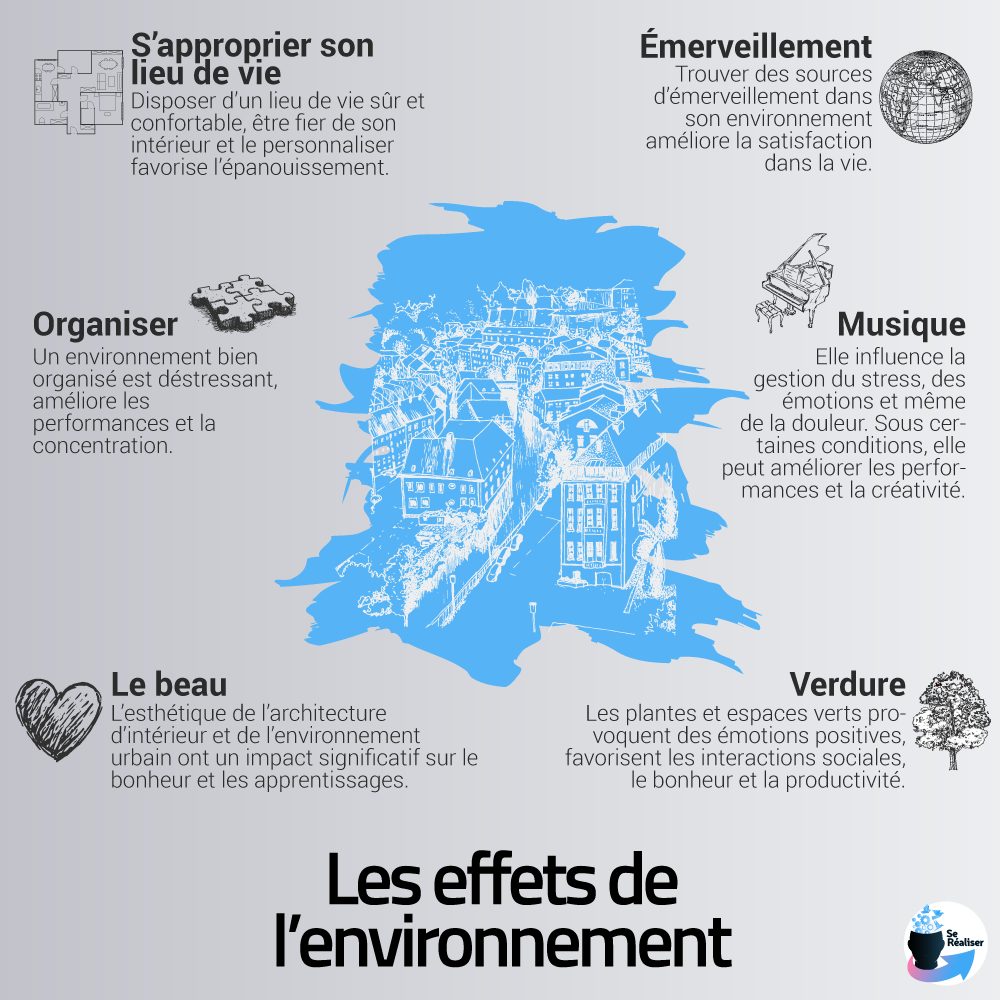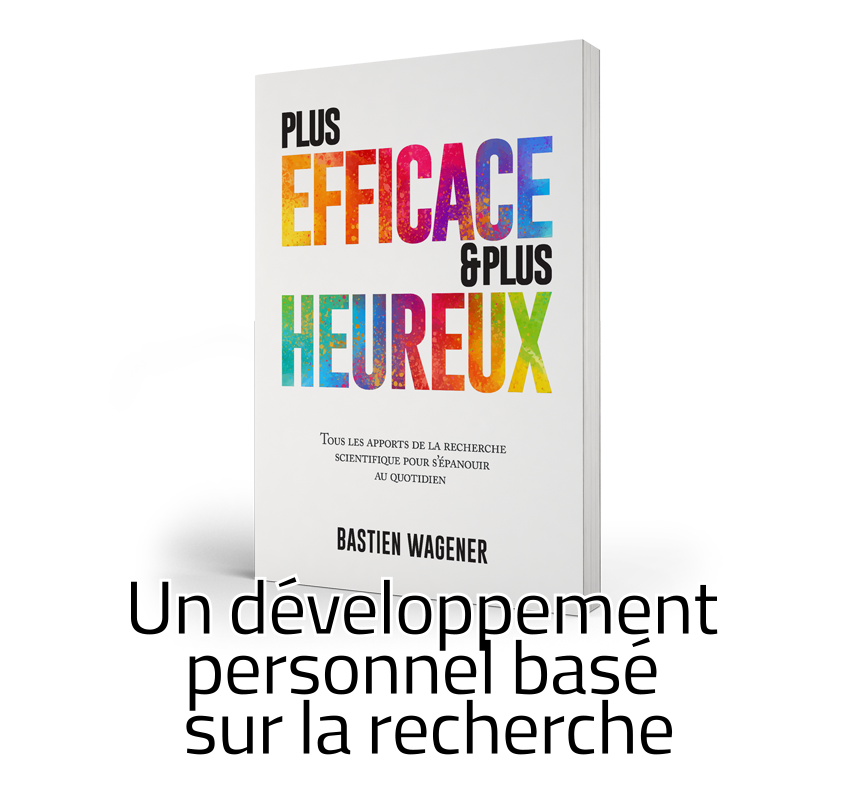Il existe de multiples moyens d’optimiser sa productivité et d’être plus épanoui au travail ou à la maison. Depuis quelques temps, les recherches en psychologie environnementale nous proposent de nombreuses pistes pour comprendre et agir sur notre environnement direct.
Dans ce chapitre du livre “Plus Efficace & Plus Heureux“, je vous propose de découvrir quelques éléments essentiels sur le sujet, mais aussi des actions concrètes pour optimiser votre qualité de vie à la maison et au travail.
Si vous souhaitez en savoir plus sur l’impact de notre environnement sur notre bonheur et notre efficacité, je vous invite à écouter le podcast.
Où écouter le podcast ?
Si vous avez aimé cet épisode et que vous voulez être notifié(e) quand le prochain sera mis en ligne, rendez vous sur Youtube, iTunes, Google Podcasts, Deezer, Spotify, TuneIn et à vous abonner.
Et enfin, si vous souhaitez soutenir ce podcast, je vous invite à l’évaluer sur iTunes, cela aide beaucoup à lui donner de la visibilité.
Mentionné dans l’émission
- Le rapport du Happiness Research Institute sur ce qui rend les gens heureux chez eux.
Pour aller plus loin
- Le livre “Plus Efficace & Plus Heureux” , disponible à partir du 12 février 2021.
Qu’avez vous pensé de cet épisode ? Quelque chose à ajouter ou à partager ? Dites-le moi en commentaire !
Références
-
Anderson, S. A., & Fuller, G. B. (2010). Effect of music on reading comprehension of junior high school students. School Psychology Quarterly, 25(3), 178‑187. https://doi.org/10.1037/a0021213
-
Avila, C., Furnham, A., & McClelland, A. (2012). The influence of distracting familiar vocal music on cognitive performance of introverts and extraverts. Psychology of Music, 40(1), 84‑93. https://doi.org/10.1177/0305735611422672
-
Ballew, M. T., & Omoto, A. M. (2018). Absorption : How Nature Experiences Promote Awe and Other Positive Emotions. Ecopsychology, 10(1), 26‑35. https://doi.org/10.1089/eco.2017.0044
-
Birkjaer, M., Henderson, A., Cencerrado Reubio, A., Drde Andersen, R., Gamerdinger, A., Kaats, M., & Wiking, M. (2019). The GoodHome Report 2019. Happiness Research Institute.
-
Brethour, C., Watson, G., Sparling, B., Bucknell, D., & Moore, T. (2007). Literature Review of Documented Health and EnvironmentalBenefits Derived from Ornamental Horticulture Products. George Morris Centre.
-
Chanda, M. L., & Levitin, D. J. (2013). The neurochemistry of music. Trends in Cognitive Sciences, 17(4), 179‑193. https://doi.org/10.1016/j.tics.2013.02.007
-
Clear, J. (2019). Un rien peut tout changer ! : Micro-actions, méga-impact, de minuscules changements vont transformer votre vie. Larousse.
-
de Witte, M., Spruit, A., van Hooren, S., Moonen, X., & Stams, G.-J. (2020). Effects of music interventions on stress-related outcomes : A systematic review and two meta-analyses. Health Psychology Review, 14(2), 294‑324. https://doi.org/10.1080/17437199.2019.1627897
-
Dur, R., & Vollaard, B. (2012). The Power of a Bad Example – A Field Experiment In Household Garbage Disposal. SSRN Electronic Journal. https://doi.org/10.2139/ssrn.2100372
-
El-Zeiny, R. M. A. (2012). The Interior Design of Workplace and its Impact on Employees’ Performance : A Case Study of the Private Sector Corporations in Egypt. Procedia – Social and Behavioral Sciences, 35, 746‑756. https://doi.org/10.1016/j.sbspro.2012.02.145
-
Ferguson, Y. L., & Sheldon, K. M. (2013). Trying to be happier really can work : Two experimental studies. The Journal of Positive Psychology, 8(1), 23‑33. https://doi.org/10.1080/17439760.2012.747000
-
Fox, K. R. (2000). The effects of exercise on self-perceptions and self-esteem. In Biddle, Stuart J. H., K. R. Fox, & S. H. Boutcher (Éds.), Physical activity and psychological well-being (p. 88‑117). Routledge.
-
Goldberg, A., Leyden, K. M., & Scotto, T. J. (2012). Untangling what makes cities liveable : Happiness in five cities. Proceedings of the Institution of Civil Engineers – Urban Design and Planning, 165(3), 127‑136. https://doi.org/10.1680/udap.11.00031
-
Graham, L. T., Gosling, S. D., & Travis, C. K. (2015). The Psychology of Home Environments : A Call for Research on Residential Space. Perspectives on Psychological Science, 10(3), 346‑356. https://doi.org/10.1177/1745691615576761
-
Hanley, A. W., Warner, A. R., Dehili, V. M., Canto, A. I., & Garland, E. L. (2015). Washing Dishes to Wash the Dishes : Brief Instruction in an Informal Mindfulness Practice. Mindfulness, 6(5), 1095‑1103. https://doi.org/10.1007/s12671-014-0360-9
-
Hassed, C., & Hassed, D. (2016). The mindful home : The secrets to making your home a place of harmony, beauty, wisdom and true happiness.
-
Hole, J., Hirsch, M., Ball, E., & Meads, C. (2015). Music as an aid for postoperative recovery in adults : A systematic review and meta-analysis. The Lancet, 386(10004), 1659‑1671. https://doi.org/10.1016/S0140-6736(15)60169-6
-
Kuo, F. E., Sullivan, W. C., Coley, R. L., & Brunson, L. (1998). Fertile Ground for Community : Inner-City Neighborhood Common Spaces. American Journal of Community Psychology, 26(6), 823‑851. https://doi.org/10.1023/A:1022294028903
-
MacKerron, G., & Mourato, S. (2013). Happiness is greater in natural environments. Global Environmental Change, 23(5), 992‑1000. https://doi.org/10.1016/j.gloenvcha.2013.03.010
-
Mehta, R., Zhu, R. (Juliet), & Cheema, A. (2012). Is Noise Always Bad? Exploring the Effects of Ambient Noise on Creative Cognition. Journal of Consumer Research, 39(4), 784‑799. https://doi.org/10.1086/665048
-
Miwa, Y., & Hanyu, K. (2006). The Effects of Interior Design on Communication and Impressions of a Counselor in a Counseling Room. Environment and Behavior, 38(4), 484‑502. https://doi.org/10.1177/0013916505280084
-
Nieuwenhuis, M., Knight, C., Postmes, T., & Haslam, S. A. (2014). The relative benefits of green versus lean office space : Three field experiments. Journal of Experimental Psychology: Applied, 20(3), 199‑214. https://doi.org/10.1037/xap0000024
-
People and places : Public attitudes to beauty. (2010). Ipsos MORI.
-
Petermans, A., & Nuyts, E. (2016). Happiness in place and space : Exploring the contribution of architecture and interior architecture to happiness. 114‑122.
-
Petermans, A., & Pohlmeyer, A. E. (2014). Design for subective well-being in interior architecture. Proceedings of the 6th Annual Architectural Research Symposium in Finland, 206‑218.
-
Renalds, A., Smith, T. H., & Hale, P. J. (2010). A Systematic Review of Built Environment and Health: Family & Community Health, 33(1), 68‑78. https://doi.org/10.1097/FCH.0b013e3181c4e2e5
-
Rudd, M., Hildebrand, C., & Vohs, K. D. (2018). Inspired to Create : Awe Enhances Openness to Learning and the Desire for Experiential Creation. Journal of Marketing Research, 55(5), 766‑781. https://doi.org/10.1177/0022243718802853
-
Rudd, M., Vohs, K. D., & Aaker, J. (2012). Awe Expands People’s Perception of Time, Alters Decision Making, and Enhances Well-Being. Psychological Science, 23(10), 1130‑1136. https://doi.org/10.1177/0956797612438731
-
Saxbe, D. E., & Repetti, R. (2010). No Place Like Home : Home Tours Correlate With Daily Patterns of Mood and Cortisol. Personality and Social Psychology Bulletin, 36(1), 71‑81. https://doi.org/10.1177/0146167209352864
-
Schellenberg, E. G., Nakata, T., Hunter, P. G., & Tamoto, S. (2007). Exposure to music and cognitive performance : Tests of children and adults. Psychology of Music, 35(1), 5‑19. https://doi.org/10.1177/0305735607068885
-
Shih, Y.-N., Huang, R.-H., & Chiang, H.-Y. (2012). Background music : Effects on attention performance. Work, 42(4), 573‑578. https://doi.org/10.3233/WOR-2012-1410
-
Sullivan, W. C., & Chang, C.-Y. (2011). Mental Health and the Built Environment. In A. L. Dannenberg, H. Frumkin, & R. J. Jackson (Éds.), Making Healthy Places (p. 106‑116). Island Press/Center for Resource Economics. https://doi.org/10.5822/978-1-61091-036-1_7
-
Taruffi, L., Pehrs, C., Skouras, S., & Koelsch, S. (2017). Effects of Sad and Happy Music on Mind-Wandering and the Default Mode Network. Scientific Reports, 7(1), 14396. https://doi.org/10.1038/s41598-017-14849-0
-
Van Herzele, A., & de Vries, S. (2012). Linking green space to health : A comparative study of two urban neighbourhoods in Ghent, Belgium. Population and Environment, 34(2), 171‑193. https://doi.org/10.1007/s11111-011-0153-1
-
Vartanian, L. R., Kernan, K. M., & Wansink, B. (2017). Clutter, Chaos, and Overconsumption : The Role of Mind-Set in Stressful and Chaotic Food Environments. Environment and Behavior, 49(2), 215‑223. https://doi.org/10.1177/0013916516628178
-
Vohs, K. D., Redden, J. P., & Rahinel, R. (2013). Physical Order Produces Healthy Choices, Generosity, and Conventionality, Whereas Disorder Produces Creativity. Psychological Science, 24(9), 1860‑1867. https://doi.org/10.1177/0956797613480186
-
Weinberg, M. K., & Joseph, D. (2017). If you’re happy and you know it : Music engagement and subjective wellbeing. Psychology of Music, 45(2), 257‑267. https://doi.org/10.1177/0305735616659552
Retrouvez la page consacrée au podcast ici : le podcast se réaliser
Mais aussi toutes les notes et précisions pour chaque épisode en suivant ce lien : pages des épisodes







Merci d’être passé(e) sur le site et d’avoir pris le temps de lire cet article ! J’espère que vous l’avez apprécié.
N’hésitez pas à me laisser un commentaire ci-dessous si vous avez des questions ou des remarques. Je fais de mon mieux pour lire et répondre à tous les commentaires postés sur le blog, alors ne soyez pas timide !
Et si vous appréciez le contenu proposé sur se-realiser.com, vous pouvez vous inscrire à notre newsletter (formulaire d’inscription dans la colonne de droite) pour rester au courant de toutes les actualités du site (pas de spam, pas de revente d’informations, rassurez-vous !).